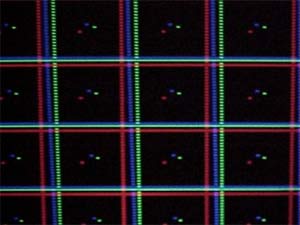 |
CRT Primer
|
Updated: April 2006 |
Analog vs Digital Convergence
 A test pattern before convergence is done
As described previously, the images of the three CRT’s need to be precisely
aligned on the screen to form a single picture. This is done by first physically
aligning the projection tubes, and then adjusting up to 300 points on the image
so that all three CRT images line up exactly.
While this sounds like a daunting task (thus one of the appeals of LCD or DLP),
in most cases the full alignment can be completed without extra test equipment,
and nothing more than a screwdriver. Even a first time CRT owner should be able
to get about 95% of the capability of a projector out of the set by completing
the alignment themselves without the help of a tech. Those not interested in
learning the procedure can hire a tech to align or converge the projector for
them. The last 5-10% of the image quality is done by a CRT tech, or those CRT
owners that find pleasure in ‘tweaking’ the image from time to time, to
compensate for tube wear or convergence drift. Note that these tweaking
adjustments take only a few minutes to complete, but of course there are those
CRT owners that tweak more than they watch the projector.
Analog convergence is found on older or entry level projectors, and typically
consist of 30 to 50 controls under the cover of the projector to align the
geometry and convergence of the unit. This procedure is a little harder to learn
than digital convergence, which is done via on screen menus that guide you
through the procedure, and a wired or wireless remote control lets you go right
up to the screen to perform exact convergence settings for an accurate picture.
While analog convergence is an older technology and a bit harder to learn,
great deals can be had on projectors with analog convergence, and as long as the
set was well built, I have not found that analog convergence drifts more than
digital convergence.
Drifting convergence is usually as much due to a shifting earth’s magnetic
field, physical jarring of the projector (vibration) as is due to drifting
component values of the convergence board.
|
|


